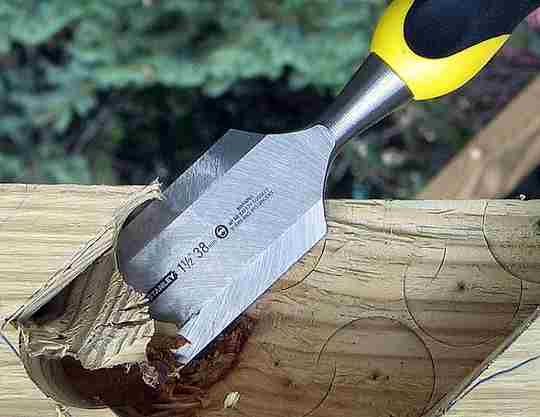 |
||||||||
Graphical Construction Glossary >> Tools. >> Hand Tools >> Bevel Edge Chisel
Socket Chisel The above tool is also a chisel that instead of having a pointed tang that fits into a hole in the handle, it has a socket, and the handle fits into that. This makes the handle a lot less prone to splitting. These chisels have the edges bevelled and because of this they are weaker than the equivalent width firmer chisel, framing chisel and mortise chisel. They require careful handling. So why use them?
The chisel above is typical of the products of modern manufacturers.
Paring Chisel. So "when I were a lad" the bench hand joiners that I served my time with all had this type of chisel. In the 32mm (1-1/14") width they would be about 300 to 350mm (12 to 14") long. They normally would be of excellent steel with boxwood handles. They were used for what we see the tool above being used for. Cleaning out, levelling off and tidying up the bottoms of the trenches in stair strings or trimming wide tenons etc.
The standard handle that fits over a tang in the chisel always has a metal ferrule at the joint to stop the wood splitting. In the example top-above it also has another ferrule at the end. The lower example is once again a socket design and the body of the chisel shows a modern trend that is to make the bevels steeper than the older versions, thereby adding a bit more strength and stiffness. If you didn't find exactly what you are looking for try this search tool that will search the site and the web. "What can be added to the happiness of a man who is in health, out of debt, and has a clear conscience? "When we build, let us think that we build for ever."John Ruskin 1819-1900 |
Hire Equipment  Furniture Fittings - Architectural Hardware - Electronic Locking Systems - Technical Hardware BuilderBill sponsorship Glossary Pages.Roof Glossary and Roofing Formwork Glossary and other tempory work. Hand Tools Glossary Power Tools Glossary Asbestos Glossary Woodwork Glossary Stair Glossary Concrete Glossary Masonry Glossary doors Glossary BuilderBill Books Building Maths  Stair Design  Asbestos Book |
|||||||
|
|
||||||||
|
Please Note! The information on this site is offered as a guide only! When we are talking about areas where building regulations or safety regulations could exist,the information here could be wrong for your area. It could be out of date! Regulations breed faster than rabbits! You must check your own local conditions. Copyright © Bill Bradley 2007-2012. All rights reserved. |
||||||||


